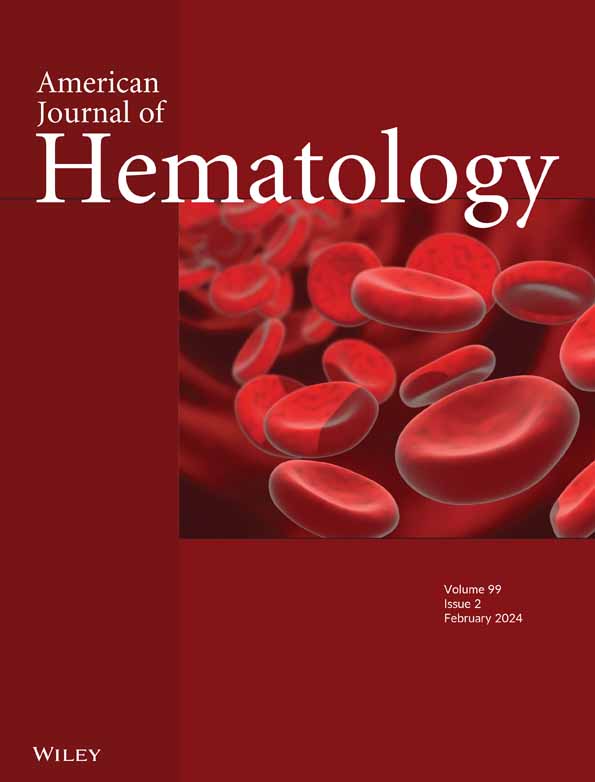Similar Outcome With Haploidentical, Matched Sibling, or Matched Unrelated Donor Hematopoietic Cell Transplantation for Adult Patients With Adverse-Risk TP53-Mutated Acute Myeloid Leukemia in First Remission: A Comparative Study From the Global Committee and the Acute Leukemia Working Party of the European Society for Blood and Marrow Transplantation.
IF 9.9
1区 医学
Q1 HEMATOLOGY
引用次数: 0
Abstract
Given the dismal prognosis for patients with TP53-mutated acute myeloid leukemia (AML), the optimal donor for those undergoing allogeneic hematopoietic cell transplantation (allo-HCT) remains unclear. We retrospectively analyzed adult patients with TP53-mutated AML who underwent first allo-HCT in CR1 between 2010 and 2021. Outcomes were compared among using a haploidentical donor (Haplo), a matched sibling donor (MSD), and a 10/10 matched unrelated donor (MUD). The analysis comprised 451 patients, including 86 Haplo, 117 MSD, and 248 MUD. Patients in the three groups were transplanted during a similar period. Haplo, MSD, and MUD groups experienced similar incidences of Day 180 Grades II-IV aGVHD (30.9% vs. 23.6% vs. 28.3%), Grades III-IV aGVHD (13.6% vs. 10.1% vs. 9.1%), 2-year cGVHD (28.9.% vs. 30.9% vs. 25.6%) and extensive cGVHD (10.9% vs. 16.1% vs. 13.3%). By multivariate analysis, the outcomes were similar in the three groups. The MSD group was associated with a similar 2-year overall survival (OS: 33.9%; p = 0.799), leukemia-free survival (LFS: 30.5%; p = 0.956), relapse incidence (RI: 54.2%; p = 0.497), non-relapse mortality (NRM: 15.3%; p = 0.368), and GVHD-free, relapse-free survival (GRFS: 21.8%, p = 0.957) when compared with the Haplo group (2-year OS: 46.7%, LFS: 37.4%, RI: 40.8%, NRM: 21.7%, GRFS: 25.7%). The MUD group also experienced a similar 2-year OS (36.9%; p = 0.892), LFS (31%; p = 0.904), RI (50.8%; p = 0.521), NRM (18.2%; p = 0.368) and GRFS (21.9%; p = 0.383) when compared with the Haplo group. In conclusion, outcomes of patients with TP53-mutated AML undergoing allo-HCT from a haploidentical donor were comparable to those from an MSD or 10/10 MUD HCT.来自全球委员会和欧洲血液和骨髓移植学会急性白血病工作组的一项比较研究:单倍同、匹配兄弟姐妹或匹配非亲属供体造血细胞移植对首次缓解的不良风险tp53突变急性髓系白血病成年患者的相似结果。
鉴于tp53突变的急性髓性白血病(AML)患者预后不佳,异体造血细胞移植(allog - hct)患者的最佳供体仍不清楚。我们回顾性分析了2010年至2021年间在CR1接受首次同种异体hct治疗的tp53突变AML成年患者。比较单倍体相同供体(Haplo)、匹配的兄弟姐妹供体(MSD)和10/10匹配的非亲属供体(MUD)的结果。该分析包括451例患者,其中Haplo 86例,MSD 117例,MUD 248例。三组患者的移植时间相似。Haplo、MSD和MUD组在第180天的II-IV级aGVHD (30.9% vs. 23.6% vs. 28.3%)、III-IV级aGVHD (13.6% vs. 10.1% vs. 9.1%)、2年cGVHD (28.9% vs. 28.1%)发生率相似。(30.9% vs. 25.6%)和广泛cGVHD (10.9% vs. 16.1% vs. 13.3%)。通过多变量分析,三组的结果相似。与Haplo组(2年OS: 46.7%, LFS: 37.4%, RI: 40.8%, NRM: 21.7%, GRFS: 25.7%)相比,MSD组的2年总生存率(OS: 33.9%, p = 0.799),无白血病生存率(LFS: 30.5%, p = 0.956),复发率(RI: 54.2%, p = 0.497),非复发死亡率(NRM: 15.3%, p = 0.368),无gvhd,无复发生存率(GRFS: 21.8%, p = 0.957)相似。与Haplo组相比,MUD组也经历了相似的2年OS (36.9%, p = 0.892)、LFS (31%, p = 0.904)、RI (50.8%, p = 0.521)、NRM (18.2%, p = 0.368)和GRFS (21.9%, p = 0.383)。总之,tp53突变的AML患者接受来自单倍体相同供体的同种异体HCT的结果与MSD或10/10 MUD HCT的结果相当。
本文章由计算机程序翻译,如有差异,请以英文原文为准。
求助全文
约1分钟内获得全文
求助全文
来源期刊
CiteScore
15.70
自引率
3.90%
发文量
363
审稿时长
3-6 weeks
期刊介绍:
The American Journal of Hematology offers extensive coverage of experimental and clinical aspects of blood diseases in humans and animal models. The journal publishes original contributions in both non-malignant and malignant hematological diseases, encompassing clinical and basic studies in areas such as hemostasis, thrombosis, immunology, blood banking, and stem cell biology. Clinical translational reports highlighting innovative therapeutic approaches for the diagnosis and treatment of hematological diseases are actively encouraged.The American Journal of Hematology features regular original laboratory and clinical research articles, brief research reports, critical reviews, images in hematology, as well as letters and correspondence.

 求助内容:
求助内容: 应助结果提醒方式:
应助结果提醒方式:


